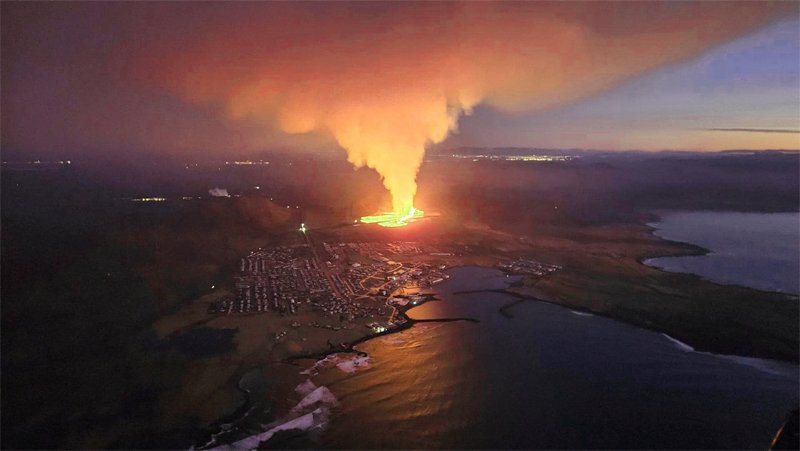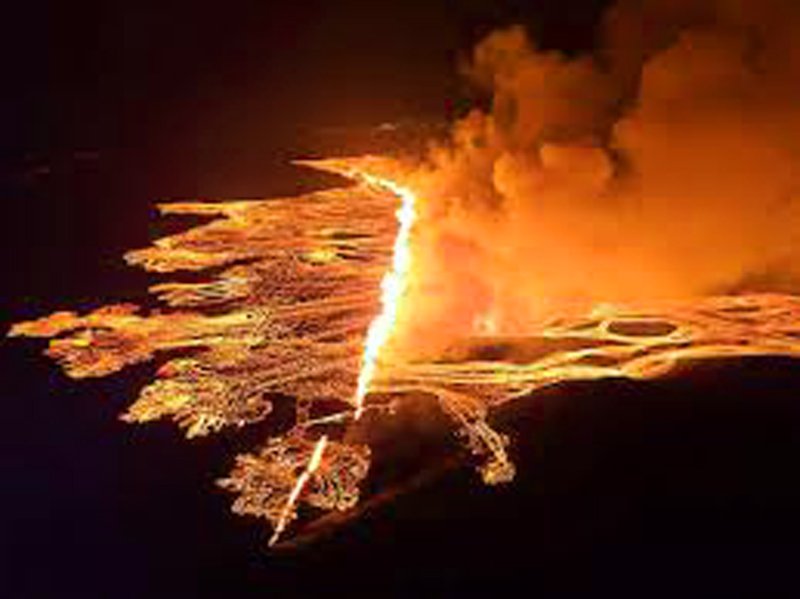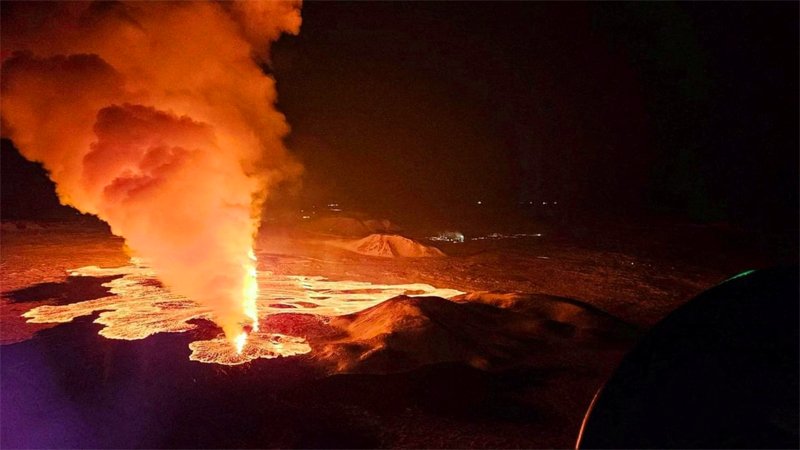
Delving Into The Recent Iceland Volcano Eruption
In the country of “Land of Fire and Ice”, such as Iceland, this name has been once again proven right, as this time volcanic eruption that started in March 2024 is recorded. Although this event is by far not as violent as some of the previous volcanic movements, it still draws attention both of scientific workers and the wider audience. In the given paper, I will take you through the exiting world of this movie, focusing on the greatness of the nature.

A Land Shaped by Fire – Iceland Volcano Eruption
Iceland is a newly formed island, separated from two continents by the edge of Mid-Atlantic Ridge. The lava flow which is a result of spreadout volcanic activity has made an enchanting island having rising mountains and steam geothermal vents. The current eruption being the continuation of the continual narrative of the volcano.
The Grindavík Eruption: A Closer Look
It originated on March 16, 2024, in Grindavík, a town in southwestern part of Reykjanes Peninsula. It is this region where series of the recent volcano activities have been witnessed, the last being the worst one. The fissure, which was a flaw in the Earth’s crust, spewed lava creating additional land and added to the steadily increasing volcanic area.
A Slow and Steady Flow
In contrast to some others that first unleash their explosive fury then, the eruption of Grindavík has taken a more gradual approach. The lava moves slowly, which allows for the authorities to surveil the current state and secure public safety. Therefore, this trait has generated an unparalleled case study for scientists to undertake more careful research.
Beneath the Surface: Magma’s Role
Powering the eruption is magma, molten rock that is far below the earth’s surface. As magma continues to build in the chamber, pressure increases until the magma finds a way to escape . This happens through an eruption on the surface. The Icelandic Met Office conducts ground deformation and seismic activity monitoring which are the indicators of magma movement and upcoming eruptions.
Impact on the Surroundings – Iceland Volcano Eruption
Volcanic eruptions can have a significant influence on their region. The Grindavík eruption has mainly affected the neighboring area where lava flows very slowly grow and create a new landscape of the volcano. While volcanic ash generally doesn’t pose a danger to air travel and human health, sometimes it can. Fortunately, the amount of ash ejected into the air has in this case been small and not caused any major problems.
Living with Volcanic Activity
The population of Iceland has witnessed numerous volcanic eruptions. They have been the side and a part of those tremendous natural forces for a long time. The country has recording equipment and disaster management plans to deal with eruptions. The strategy is preventative in nature and consequently minimizes risks and arranges for the safety of both the residents and visitors.
A Scientific Spectacle – Iceland Volcano Eruption
Volcanic eruptions give scientists an opportunity to observe how the Earth functions from within. This can be achieved by the analyzing of lava composition, gas emissions, and seismicity events. Our volcano, Grindavík that is currently eruption, never stops giving more details to volcanologists all over the world.
The Future: What Lies Ahead?
It is hard to say how long the eruption of Grindavík will last. Previous blasts over this place had gone on for several weeks or even months. Geologists assess the technological developments and base their predictions on the monitoring of ground motion, seismicity and magma accumulation that they have obtained .
Such an eruption shows us the vivid energy of Earth and the features of our planet. The volcanoes always produce upheaval, and this is also the reason why the landscapes and the ecosystems exist. This awareness will assist us to be more effective in anticipating future threats, and by adapting to the changing nature of the planet, we can co-exist and experience prosperity.

Iceland’s Volcanic Fury: Beyond the Headlines
Volcanic eruptions in themselves are exciting events that superficially may get the attention of the news for mere spectacle. Let’s dive deeper into the not much discussed Iceland’s recent volcanic eruption.
Tourism and the Eruption
Iceland’s volcanic stscapes is a major reason to visit that place for tourists. The Grindavík breakout has added a new side to this appeal, with many travelers eager to see the water fireworks for the first time. Nonetheless, safety is the one that should be managed properly. The officials are having viewing places which are at a safe distance from the lava. Responsible tourism activities are utterly important in order to guarantee the safety of tourists and reduce inconvenience to local people
Environmental Considerations
Volcanic eruptions have a lot of intricately woven environmental impacts. Although the impact of Grindavík eruption is small in the immediate relief, long-term effects need to be addressed as well. Volcanic gases are the main source of air pollution and their deposition may negatively affect plant and animal life. Scientists are keeping track of those factors to evaluate the eruption level impact on the environment.
Geothermal Energy: A Silver Lining
Iceland uses geothermal energy (heat from the Earth’s interior) to provide the majority of its electricity. Volcanic activity contributes greatly to the refilling of these underground geothermal reservoirs. The continual eruption may contribute to the long-term sustainability of Iceland’s renewable energy production.
The Social and Cultural Impact
Weaving of volcanic eruptions into the fabric of Icelandic culture is inseparable. In folklore and mythology, the volcanoes is viewed as a powerful being. The eruption sparked the revival of some of these traditions hence giving a glimpse into the Icelanders deep connection with the volcanic landscape.
The Economic Repercussions
Volcanic eruptions will affect both positively and negatively economy. While the eruption-motivated tourism can bring temporary positive effects to the local economy, travel interruptions or the collapse of infrastructure may result in many problems. Iceland learned from the previous situations how to handle these economic complications.
The Global Connection – Iceland Volcano Eruption
The volcanoes in Iceland can sometimes cause problems world wide. Large volcano eruptions may emit vast amounts of ash into the air, thereby creation of problems for air traffic on a global scale. Fortunately, the Grindavík eruption hasn’t led to the same level of disruptions in people lives that the 2010 eruption caused. While it alerts us to the close bond of our planet and the influence it can have around the world, it is also a demonstrator of it.
Looking Ahead: Research and Innovation
The study of volcanic eruption is an essential step in the effort to know these natural phenomena. The records obtained during the Grindavík eruption will add to the progress in the volcanic forecasting and hazard dealing. It can be used not only in Iceland but it will also be very helpful for the volcanically active areas in other parts of the world.
In the process of investigating the particulars of the eruption of Iceland’s volcano, we expand our knowledge and appreciate its scale. This emotional show does not just brag about the planet and the ever-changing worlds but also teaches people the communities that live with such strong forces of nature.
Iceland’s Volcanic Fury: The Human Story
More than the incredible scientific concepts and amazing visuals, volcanic eruptions affect the lives of those living nearby in a host of ways. Come with me and let’s discover the human tale behind Iceland’s recent volcanic eruption.
Capability of survival against nature’s might .
Icelanders have the ability to display great resilience which is astonishing. They have chronicles of adulation to the volcanoes and the volcanic activity. The Grindavík eruption (being the current one), despite all the trouble it is causing, hasn’t pushed people off their land nor brought about wide-scale destruction. Nonetheless, denizens whose life is in the epicenter of the eruptious event might be uncomfortable at all.
Community and Collaboration
Volcanic eruptions develop a sense of unity and solidarity of people. In these situations, the community pools their resources by sharing information, giving aid to one another and planning for the hazards to come. Local authorities collaborate very closely with communities in order to ensure safety and to provide the required resources.
The Power of Information – Iceland Volcano Eruption
Volcanic eruptions requires availability of accurate and timely information otherwise they will not be useful. Iceland has a well-organized emergency communication system. The authorities provide residents with regular updates as well as advisories and guidelines for self-preservation measures through frequent instructions.
The Economic Impact on Individuals – Iceland Volcano Eruption
While tourism connected to the eruption can be profitable for some, for others it would be a loss. The ongoing eruption may cause temporary shutdown of businesses located near the volcano. People who make their living from farming or tourism could face losses in the near future.
Long-Term Recovery and Rebuilding
Volcanic eruptions will have their mark on local infrastructures. Lava flows cause destruction of roads, buildings and other assets. The eruption’s severity might determine the lengthy recovery and rebuilding plans.
The Psychological Impact – Iceland Volcano Eruption
To watch the volcanic eruption as a spectator, it’s a singular and exciting event. It can help reduce stress levels at times but it can also serve as a trigger for stress and aggravate anxiety, particularly among those living in densely populated areas. The mental health support programs is available all time, which is aimed to help people handle emotional problems resulting from volcanic activity.
A Shared Experience: Iceland and the World
The volcanic eruptions of Iceland instantly fascinate the whole world. That occasion has given rise to discussions concerning volcanic hazards, disaster readiness and force of nature. Through the exchange of their stories and wisdom, Icelanders can help to shape global strategies for mitigating volcanic hazards.
The Power of Storytelling — Iceland Volcano Eruption
Volcanic eruptions become matters for folklore and cultural development. Icelandic art, literature and music may take this eruption into consideration as a source of inspiration to be able to express and then reflect the impact of the event on their personal lives and communities. These stories provide a pane through which we can see the human spirit’s encounter with a volcanic area.
Through the lens of the human narrative behind Iceland’s volcanic outbreak, we realize that these challenges and triumphs of people in the frontline are not left out. It underlines the role of communities, the ability to adapt, and eternal human nature as inhabitants in harmony with the wild, capricious, and powerful natural surroundings.
Conclusion – Iceland Volcano Eruption
Iceland’s Volcanic Fury: A Force of Change
Iceland’s recent eruption is a living proof that nature is never stable and is continually producing dynamic forces. It’s a mind-blowing show, a scientific phenomenon, and a story of our struggle for survival.
This fiery display has profoundly modified the terrain, arrested the planet’s attention and opened our eyes on the terrestrial rudiments. Although the immediate impacts haven’t been to the extent they could be, the volcano’s long-term environmental and economic impacts are yet to be fully revealed.
The event has shown the imperative contribution of science and preparedness in mitigating volcanic risks. Data gathered throughout the eruption will be an input into the development of advanced models, thus helping to save lives in communities all over the world.
The manner with which Iceland handled the eruption is illustrative of the value of collaborative community as well as effective communications. Through their access to their deep cultural roots and knowledge of volcanic affairs, the Icelanders manage to go through these events with both respect and strength.
The Icelandic volcano eruption tale is just starting at this point. The eruption itself though may eventually subside, but its lasting impact will continue to transform the landscape, the lives of the local communities, and impact the scientific understanding of these natural forces. From this event, we witness and acquire a deeper understanding of the phenomenal beauty of the earth, whose design and composition are ever changing.

